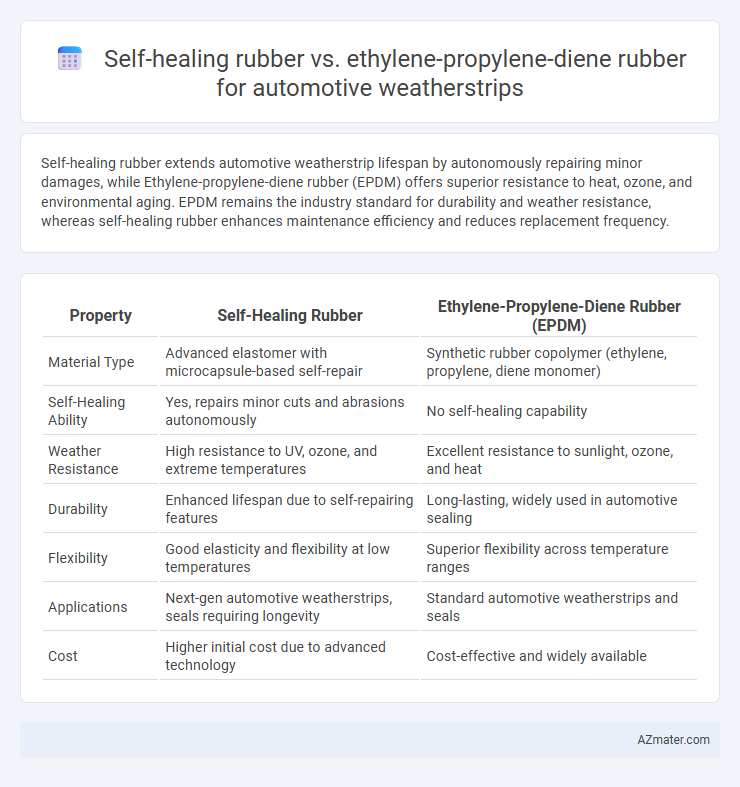Self-healing rubber extends automotive weatherstrip lifespan by autonomously repairing minor damages, while Ethylene-propylene-diene rubber (EPDM) offers superior resistance to heat, ozone, and environmental aging. EPDM remains the industry standard for durability and weather resistance, whereas self-healing rubber enhances maintenance efficiency and reduces replacement frequency.
Table of Comparison
| Property | Self-Healing Rubber | Ethylene-Propylene-Diene Rubber (EPDM) |
|---|---|---|
| Material Type | Advanced elastomer with microcapsule-based self-repair | Synthetic rubber copolymer (ethylene, propylene, diene monomer) |
| Self-Healing Ability | Yes, repairs minor cuts and abrasions autonomously | No self-healing capability |
| Weather Resistance | High resistance to UV, ozone, and extreme temperatures | Excellent resistance to sunlight, ozone, and heat |
| Durability | Enhanced lifespan due to self-repairing features | Long-lasting, widely used in automotive sealing |
| Flexibility | Good elasticity and flexibility at low temperatures | Superior flexibility across temperature ranges |
| Applications | Next-gen automotive weatherstrips, seals requiring longevity | Standard automotive weatherstrips and seals |
| Cost | Higher initial cost due to advanced technology | Cost-effective and widely available |
Introduction: Evolution of Automotive Weatherstrip Materials
Self-healing rubber represents an advanced innovation in automotive weatherstrip materials, offering enhanced durability by autonomously repairing microcracks caused by environmental stress. Ethylene-propylene-diene monomer (EPDM) rubber has long been the industry standard due to its excellent ozone resistance, flexibility, and weathering performance essential for sealing and insulation. The evolution from EPDM to self-healing rubber marks a significant technological leap, improving longevity and reducing maintenance costs in automotive seals exposed to UV radiation, temperature fluctuations, and mechanical wear.
Overview of Self-Healing Rubber Technology
Self-healing rubber technology in automotive weatherstrips enables materials to autonomously repair microcracks caused by environmental stress, enhancing durability and lifespan. This innovation contrasts with conventional Ethylene-Propylene-Diene Monomer (EPDM) rubber, known for excellent weather resistance but lacking intrinsic self-repair capabilities. Incorporating microcapsules or dynamic covalent bonds, self-healing rubbers provide advanced protection against UV exposure, ozone, and temperature fluctuations common in automotive applications.
Ethylene-Propylene-Diene Rubber (EPDM): Properties and Applications
Ethylene-Propylene-Diene Rubber (EPDM) exhibits exceptional resistance to heat, ozone, and weathering, making it a preferred choice for automotive weatherstrips. Its excellent elasticity, durability, and ability to maintain flexibility in extreme temperatures enhance sealing performance against water, dust, and air infiltration. EPDM's chemical inertness and compatibility with various automotive adhesives and coatings contribute to its widespread use in weatherstrip applications for doors, windows, and trunks.
Mechanical Performance Comparison: Durability and Flexibility
Self-healing rubber exhibits superior durability by autonomously repairing microcracks caused by environmental stress, significantly extending the lifespan of automotive weatherstrips compared to Ethylene-Propylene-Diene Monomer (EPDM) rubber. EPDM provides excellent flexibility and weather resistance but lacks self-repairing capabilities, which can lead to eventual material degradation and reduced sealing performance under prolonged exposure to UV radiation and temperature fluctuations. Mechanically, self-healing rubber enhances long-term flexibility retention and resilience against mechanical deformation, making it a promising advancement over traditional EPDM for automotive sealing applications.
Weather Resistance: Self-Healing Rubber vs EPDM
Self-healing rubber exhibits enhanced weather resistance compared to Ethylene-Propylene-Diene Monomer (EPDM) by autonomously repairing micro-cracks caused by UV exposure and ozone, extending the lifespan of automotive weatherstrips. EPDM is known for its excellent resistance to heat, ozone, and oxidation, yet it lacks the self-repairing capability, which can lead to gradual degradation under prolonged harsh weather conditions. The self-healing property significantly improves durability and maintains sealing performance in automotive weatherstrips exposed to extreme environmental factors.
Longevity and Maintenance: Cost Implications
Self-healing rubber offers enhanced longevity for automotive weatherstrips by automatically repairing minor cuts and abrasions, reducing the frequency of replacements and maintenance costs. Ethylene-propylene-diene rubber (EPDM) provides strong resistance to weathering and ozone but lacks self-repair properties, leading to higher long-term maintenance expenses due to more frequent inspection and replacement. Choosing self-healing rubber can lower total cost of ownership by minimizing downtime and repair interventions compared to EPDM in automotive sealing applications.
Environmental Impact and Sustainability Factors
Self-healing rubber in automotive weatherstrips reduces environmental waste by extending product lifespan and minimizing the need for replacements, thereby lowering raw material consumption and landfill contributions. Ethylene-propylene-diene rubber (EPDM) is durable and resistant to UV and ozone but is derived from non-renewable petrochemical sources, raising concerns about resource depletion and carbon emissions. Incorporating self-healing properties into EPDM formulations can enhance sustainability by combining durability with reduced environmental impact, promoting a circular economy in automotive sealing applications.
Ease of Manufacturing and Integration
Self-healing rubber offers significant advantages in automotive weatherstrip manufacturing by reducing defect rates and simplifying quality control due to its autonomous crack repair capabilities, which enhances production efficiency. Ethylene-propylene-diene rubber (EPDM) is well-established for ease of processing with proven vulcanization techniques and compatibility with existing molding equipment, facilitating straightforward integration into current manufacturing lines. While self-healing rubber may require adjustments in curing parameters or material handling, its potential to extend weatherstrip lifespan can offset integration challenges through reduced warranty claims and maintenance.
Market Trends: Adoption in the Automotive Industry
The automotive industry is increasingly adopting self-healing rubber for weatherstrips due to its superior durability and ability to autonomously repair minor damages, reducing maintenance costs and vehicle downtime. Ethylene-propylene-diene rubber (EPDM) remains widely used for its proven resistance to weathering, ozone, and temperature extremes, maintaining strong market presence in traditional applications. Emerging market trends indicate a gradual shift towards self-healing elastomers driven by advancements in polymer technology and growing demand for sustainable vehicle components.
Future Outlook: Innovations and Potential Challenges
Self-healing rubber for automotive weatherstrips offers promising advancements in durability and maintenance reduction by autonomously repairing micro-damages, potentially extending service life beyond the traditional Ethylene-Propylene-Diene Monomer (EPDM) rubber. Innovations focus on enhancing polymer network designs and integrating nanomaterials to improve self-repair efficiency under diverse environmental conditions, while maintaining flexibility and resistance to weathering. Challenges include scaling manufacturing processes, ensuring long-term stability without compromising mechanical properties, and meeting cost-effectiveness for widespread automotive industry adoption.

Infographic: Self-healing rubber vs Ethylene-propylene-diene rubber for Automotive weatherstrip
 azmater.com
azmater.com